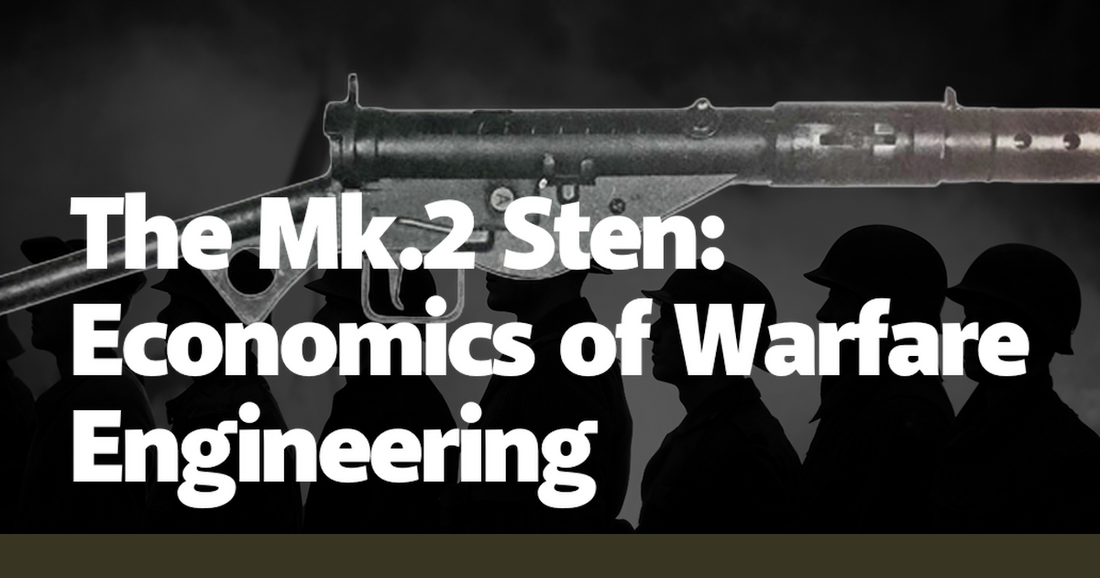The Mk.2 Sten, a submachine gun that became emblematic of British ingenuity during World War II, stands as a testament to the economics of warfare engineering. Conceived in the dire straits of early 1941, when the British Army faced severe shortages of firearms, the Sten was designed to be both cost-effective and quickly manufacturable. The exigencies of war necessitated a weapon that could be produced en masse without compromising on functionality. The result was a firearm that, while lacking the finesse of its German counterparts, delivered reliability and simplicity, embodying the very essence of wartime pragmatism.
The Sten’s design process was a masterclass in frugality and efficiency. Unlike the Thompson submachine gun, which was expensive and time-consuming to produce, the Sten was constructed from simple stamped metal parts and a few machined components. Its design eschewed wooden stocks and other non-essential elements, making it cheaper and faster to manufacture. The manufacturing cost of a single Sten Mk.2 was approximately £2 10s, compared to the £70 for a Thompson. This stark difference in cost allowed the British to arm their troops more effectively despite the constraints of their wartime economy.
The simplicity of the Sten’s design also facilitated its rapid production. Factories that had never before produced firearms could be retooled to manufacture Stens, a crucial advantage when speed was of the essence. Anecdotal evidence from wartime production lines reveals that even unskilled laborers could be quickly trained to assemble the weapon. This adaptability was vital as the British workforce had been significantly depleted by conscription. The ability to churn out thousands of Stens in a short period was a critical factor in bolstering the British war effort and maintaining a steady supply of arms.
Despite its utilitarian design, the Sten Mk.2 was not without its quirks and flaws. Soldiers often referred to it as the “Plumber’s Nightmare” due to its rudimentary appearance. The weapon’s tendency to jam if not properly maintained was a frequent complaint. However, its advantages far outweighed its drawbacks. The Sten’s light weight and compact size made it ideal for paratroopers and resistance fighters. Its 32-round magazine provided a significant firepower advantage in close-quarters combat, a crucial factor in the urban warfare that characterized much of the fighting in Europe.
The Sten also played a significant role in the clandestine operations of resistance movements across occupied Europe. The weapon’s low cost and ease of production meant that it could be supplied in large quantities to resistance fighters, who often operated with minimal resources. The Sten’s disassembled parts could be smuggled past enemy lines and quickly reassembled in the field. Stories abound of resistance fighters using Stens to great effect in sabotaging Nazi operations and aiding Allied forces. The weapon became a symbol of resilience and ingenuity, embodying the spirit of those who fought against tyranny with limited means.
One of the most compelling aspects of the Sten’s story is its impact on post-war firearm design. The principles of simplicity and cost-effectiveness that guided its creation influenced subsequent generations of military weapons. The AK-47, perhaps the most famous example, shares the Sten’s emphasis on ease of production and reliability. The legacy of the Sten can be seen in modern firearms that continue to prioritize these attributes, underscoring the enduring relevance of its design philosophy.
The economic implications of the Sten’s production extended beyond the battlefield. The weapon’s manufacture spurred innovations in industrial processes and materials science. The techniques developed to produce the Sten quickly and cheaply were later adapted for civilian industries, contributing to the post-war economic recovery. The Sten’s story is thus not only one of military necessity but also of broader economic impact, demonstrating how wartime exigencies can drive technological and industrial advancements with lasting effects.
In conclusion, the Mk.2 Sten submachine gun is a remarkable example of the economics of warfare engineering. Its design and production were driven by the urgent need for a cost-effective, easily manufacturable weapon during World War II. While it had its flaws, the Sten’s simplicity, reliability, and adaptability made it a crucial asset to the British war effort and a symbol of resistance across Europe. Its influence on post-war firearm design and industrial processes further underscores its significance. The Sten’s legacy is a powerful reminder of how innovation can flourish under the most challenging circumstances, leaving an indelible mark on history.

